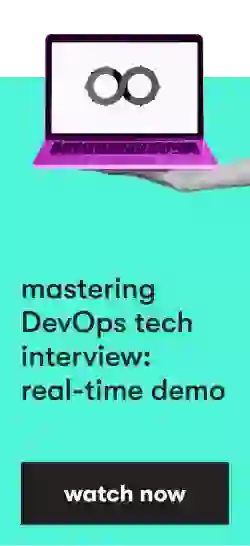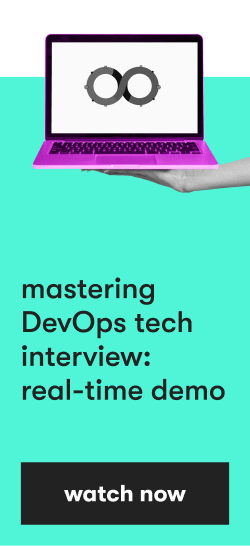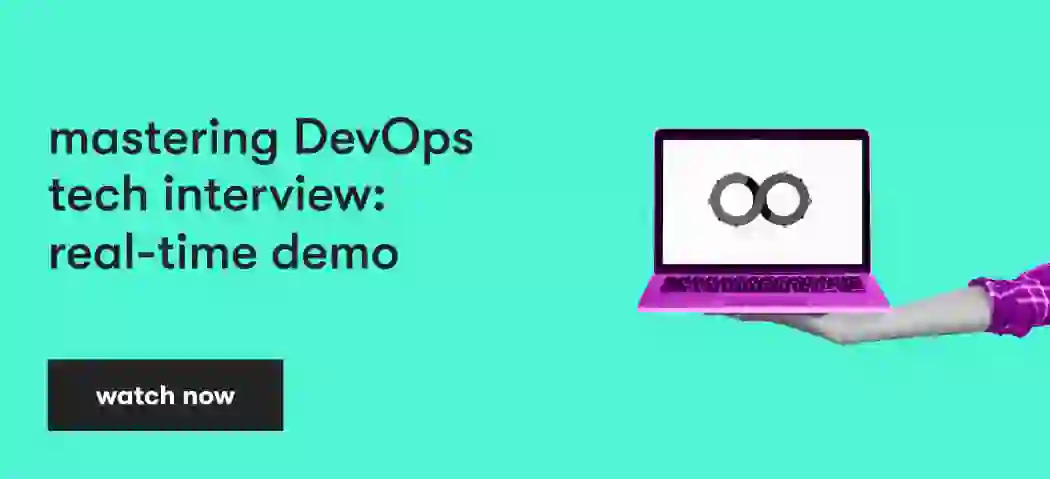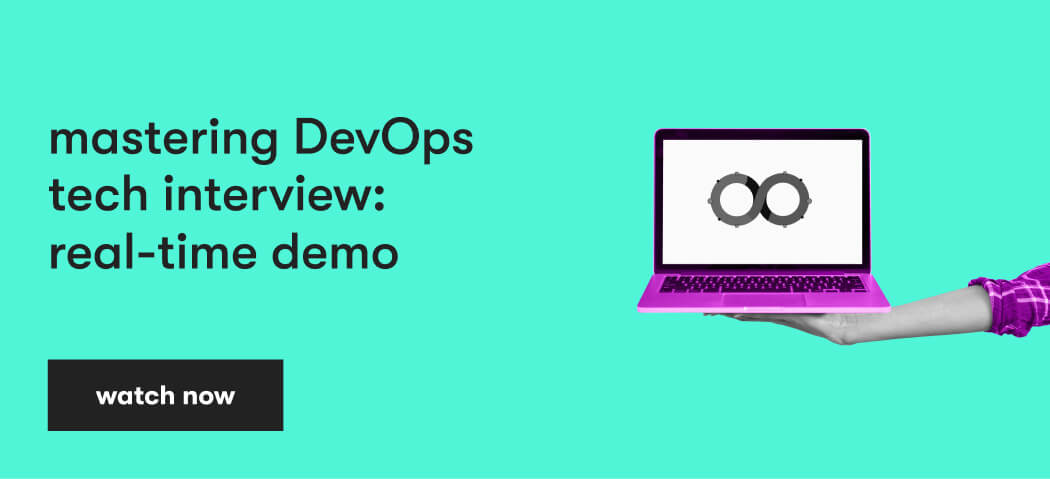According to CodinGame's 4th annual report published in 2021, the DevOps engineer position was the most in-demand developer position, ahead of data scientists and software engineers. More and more developers are choosing to transition to a DevOps engineering role.
According to a poll of more than 15,000 engineers and HR experts, 43% of firms anticipate difficulty filling DevOps jobs. Applicants for both on-site and remote DevOps engineer jobs can expect a successful career, helped by market demand and a shortage of supply.
So, how do you maximize your chances of getting the right job for you by skillfully responding to DevOps engineer technical interview questions?
Depending on the corporate architecture of the project you are discussing, the specific tech stack could differ. Still, some common DevOps engineer interview questions are asked during most interviews, as provided by Yury Kachubeyeu, Systems Engineering Manager and DevOps Technical Interviewer, EPAM.
1. What is DevOps?
DevOps is a combination of development and operations. It is an approach to software engineering that marries the operations team and the development team with the goal of automating routine tasks at every level.
To support operational goals and enhance awareness of the technical stack used in the production environment, this approach makes it simple to automate project service management.
DevOps is aligned with Agile approaches, and primarily emphasizes cooperation, resource planning, and communication.
Companies hiring DevOps engineers intend to improve the pace of development and facilitate problem-solving and innovation in the production environment, and enhance the reliability of applications.
My interview at EPAM Anywhere was about two hours long and was quite challenging. It covered a full list of topics like CI/CD tools, my experience with cloud and on-premise, sysadmin questions related to Linux, as well as questions related to IaC, architecture, and leadership.

2. Identify the main DevOps tools
DevOps engineer interview questions for experienced applicants are not limited to technical details, they also assess how well you know your tools.
DevOps aims to boost productivity and improve the quality of product development using tools that include:
- Version control system tools (Git, CVS, SVN, Mercurial, Monotone, etc.)
- Continuous integration tools (Jenkins, TeamCity, GitLab CI, Buddy, Bamboo, etc.)
- Continuous testing tools (Katalon, Watir, Tosca, Eggplant, Selenium Testsigma, etc.)
- Configuration management and deployment tools (Ansible, SaltStack, Juju, Auvik, CFEngine, etc.)
- Continuous monitoring tools (Sensu, PagerDuty, Librato, Prometheus, etc.)
- Containerization tools (Kubernetes, OpenShift, Packer, Marathon, Nomad, etc.)
Most interviewers and candidates know Jenkins, but if you don’t, please clarify at the very beginning of the interview that you are not using Jenkins and that you manage the deployments with other tools.

3. What is continuous integration?
As soon as they finish working on a feature, developers must integrate their code into a common repository using the continuous integration (CI) method.
Each integration is checked using an automated build process, which enables teams to identify issues with their code even before it is released.
The primary advantage of CI is that it shields the project team from a broad range of problems related to code integration, greatly accelerating the development cycle.
4. What challenges exist when creating DevOps pipelines?
New features and database migrations cause problems that make DevOps processes more difficult and will come up during the interview questions and answers for DevOps engineer posts.
Within CI setups, feature flags are typically used to manage gradual product releases, limiting the risk of new features.
If a scheduled job that involves a database migration fails, the system could be rendered inoperable. There are several strategies to avert and minimize issues that may arise:
- Start the deployment in stages. The pipeline's initial step kicks off the application's build procedure and the application context is used to execute the migrations. The deployment process will start if the migrations are successful; otherwise, the application won't deploy.
- Require that all migrations be backwards compatible. Use feature flags to implement all features. As a result, application rollbacks are separate from database rollbacks.
- Create a Docker-based program that builds a fresh, isolated production mirror with each deployment. On the clone/mirror, integration tests can be performed without the risk of damaging crucial infrastructure.
- Use database migration solutions that permit rollbacks.
5. What differentiates CI from CD?
CD stands for continuous deployment or continuous delivery. Continuous integration (CI) forms the foundation for both continuous deployment and delivery.
While CI automates the build, continuous deployment and continuous delivery automate releases.
Although the goal of continuous delivery is to create software ready to be published at any time, production releases are still created manually at the discretion of a decision-maker. Continuous deployment takes it up a notch and delivers these elements to operational systems.
Be sure you know the whole flow of CI/CD, the differences between continuous deployment and continuous delivery, ways to manage multiple environments, different deployment strategies (Rolling, B/G, Canary), and how to debug at every step.

6. Describe common deployment patterns (for Senior DevOps)
Canary Releases and Blue Green Deployments (BGD) are the most prevalent deployment patterns.
When using BGD, you need two identical environments. The existing production system is housed in a "green" environment, and the "blue" environment is where deployment takes place.
When everything is running smoothly, elements are moved from the "green" environment to the "blue" environment after the "blue" environment has been checked for errors.
To lower the risk associated with delivering new properties, Canary Releases come in handy in rolling out particular features to a small group of users first.
7. How do containers communicate in Kubernetes? (for Senior DevOps)
In Kubernetes, a pod is a mapping between containers. There are one or more containers inside a pod. Any pod inside the overlay network may theoretically speak to any other pod, since pods have a flat network hierarchy and communicate with one another in a flat style.
8. Describe infrastructure as code (IaC) and configuration management (for Senior DevOps)
The IaC paradigm controls and monitors infrastructure settings in files rather than doing so manually or through graphical user interfaces. This enables a more flexible setup of the infrastructure and, more significantly, open tracking of modifications using a versioning system.
Software programs known as configuration management systems enable the consistent, dependable, and secure control of an environment.
Multiple individuals may collaborate and save the system configuration of multiple servers in a single location using an efficient DSL (domain-specific language) to specify the state and configuration of the system's components.
One of the earliest generations of contemporary business configuration management technologies was CFEngine.
By automating processes like software installation, and establishing and defining roles, users, and groups, the goal was to create a replicable environment.
Configuration management has become widely available thanks to second-generation systems. Chef and Puppet are examples of systems that operate in independent mode, but are typically set up in agent/master mode, where the latter passes settings to the concerned agents.
Ansible is a newer solution and is well-liked because of its simplicity. It has no centralized server and the configuration is saved in YAML. The state configuration is sent to the servers using SSH (or WinRM on Windows), where it is subsequently executed.
The drawback of this method is that it loses speed when managing several machines.
Tips and tricks for your next interview
If you have managed to secure an interview, it is imperative that you make time to prepare adequately. The field is highly competitive and most of the applicants are qualified. Below are a few tips to help you ace your interview questions at EPAM Anywhere and elsewhere:
- Be confident. Interviews are designed to put you to the test. Many people find themselves flustered during interviews, but it is important that you appear confident. This gives the interviewers faith in your capabilities. There is no magic formula for confidence, but a good first step is to ensure that you have all the relevant documents and an in-depth knowledge of your field.
- Make sure you are well-informed about data structures and algorithms. Part of the DevOps job description is development, so you must know how to code. Practice your coding skills in preparation for the interview.
- Be ready to design different systems. As a DevOps engineer, you will be required to design efficient systems that are accessible widely. In your interview, you must be able to demonstrate how to develop such a system. This highlights your ability to see the big picture.
- Learn Linux fundamentals. In your DevOps role, you will be required to know Linux infrastructure from Kernel to command line commands.
- Have a deep understanding of parsing tools like awk, sed, and grep.
- Thoroughly familiarize yourself with DevOps tools like Kubernetes, Docker, and Terraform.
- Keep track of new developments. The world of IT moves quickly and there are new developments every day. You must stay on top of trends and emerging concepts. You can do this by keeping in touch with like-minded individuals and updating each other, or by using podcasts, YouTube videos, publications, and newsletters. This demonstrates to the interviewers your interest and the value you will add to the team.
During my interview, I was asked some architecture questions. Even though I have architect certifications, there were some concepts, like preparing enterprise solutions and being business-first, that I wish I could have answered more effectively — with a proper and professional solution responsive to the requirements I received.

Many companies are phasing out working from the office in favor of remote working. If you have the necessary skills and an interest in working on projects for top global brands, check out our remote jobs and start your journey today.
Thanks to Yury Kachubeyeu, Systems Engineering Manager and DevOps Technical Interviewer, EPAM, for reviewing and contributing to this guide.

As Chief Editor, Darya works with our top technical and career experts at EPAM Anywhere to share their insights with our global audience. With 12+ years in digital communications, she’s happy to help job seekers make the best of remote work opportunities and build a fulfilling career in tech.
As Chief Editor, Darya works with our top technical and career experts at EPAM Anywhere to share their insights with our global audience. With 12+ years in digital communications, she’s happy to help job seekers make the best of remote work opportunities and build a fulfilling career in tech.
Explore our Editorial Policy to learn more about our standards for content creation.
read more























